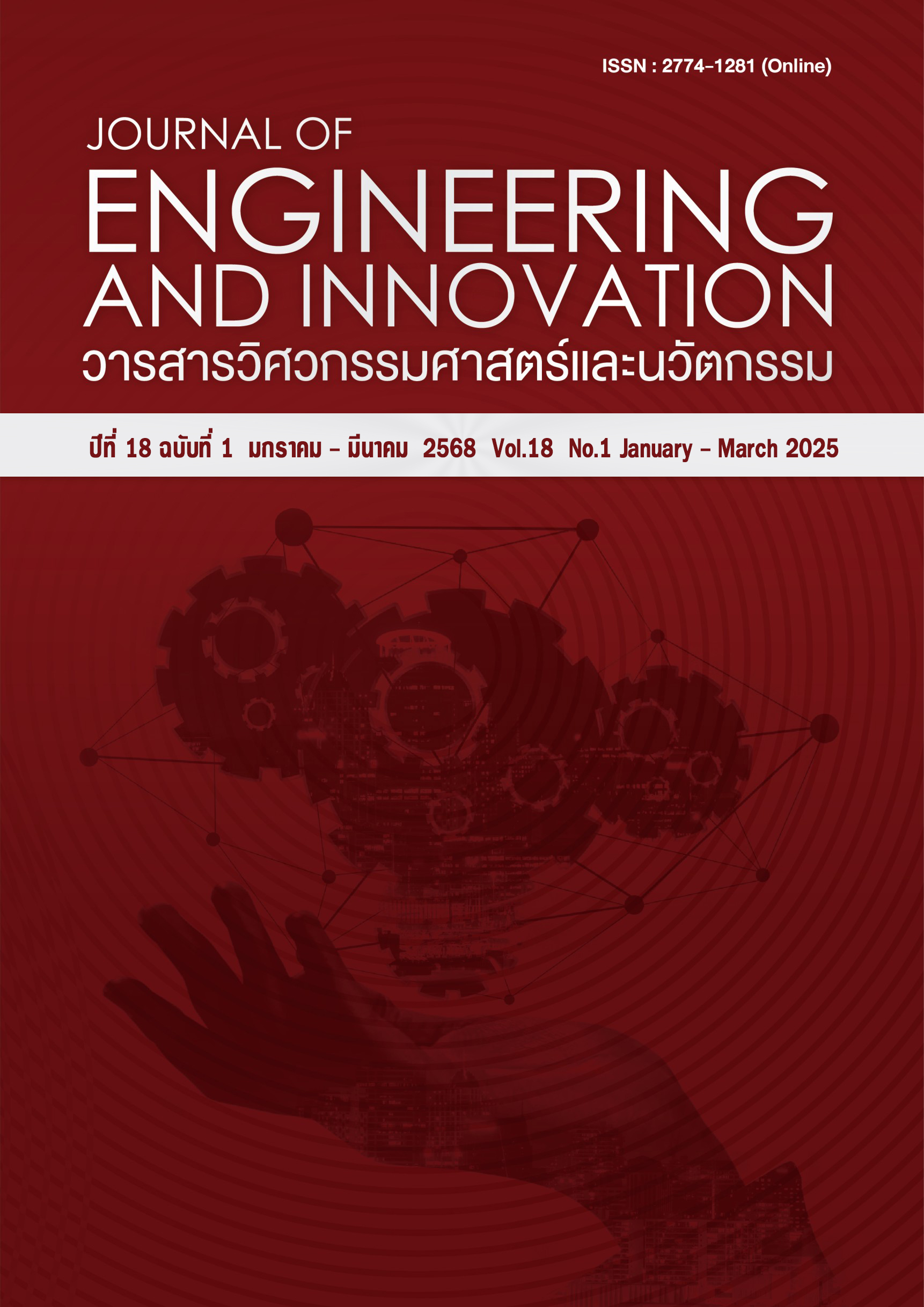Non-destructive inspection of cracked coconut fruit using a small portable near-infrared spectrometer
Main Article Content
Abstract
The spoilage of young coconuts due to internal cracking is a significant issue for selling young coconuts, as farmers cannot detect the cracks from the outside. This results in cracked coconuts being passed on to importers or buyers, causing them to lose confidence in the product's quality. Therefore, this research aims to develop a non-destructive method to detect internal cracking in young coconuts using a small portable near-infrared spectrometer with a wavelength range of 900-1700 nm, utilizing the reflectance mode for measurement. The absorbance data of young coconuts from the near-infrared spectroscopy were analyzed to create qualitative prediction equations for classifying cracked and normal coconuts groups using Partial Least Squares-Discriminant Analysis (PLS-DA) and Discriminant Analysis (DA). The results found that the absorption values which were pretreated using mathematical Standard normal variate (SNV) method gave the best classification accuracy result of 72.34% and 74.47%, respectively from the unknown sample group. This research demonstrated that a small portable near-infrared spectrometer could help detect cracked and normal coconuts in a convenient, fast, and non-destructive manner. However, the predictive equation should always be improved by collecting additional samples with yearly variations in chemical properties to enhance the accuracy of the prediction.
Article Details
References
สำนักงานเศรษฐกิจการเกษตร. การนำเข้าและส่งออกมะพร้าว. เข้าถึงได้จาก: https://mis-app.oae.go.th. [เข้าถึงเมื่อ 11 มกราคม 2567].
สถาบันวิจัยพืชสวน กรมวิชาการเกษตร. สถานการณ์การผลิตมะพร้าว. เข้าถึงได้จาก: https://www.doa.go.th/
hort/wp-content/uploads/2020/10/สถานการณ์มะพร้าว_กรกฎาคม63.pdf. [เข้าถึงเมื่อ 13 พฤศจิกายน 2566].
พงษ์นาถ นาถวรานันต์. ผลของความถี่ในการให้น้ำต่อการแตกของผลมะพร้าวน้ำหอม. วารสารเกษตรพระจอมเกล้า. 2559; 33(4): 39–47.
ธนาโชค ตติเจริญ. ปัจจัยการเกิดการแตกในมะพร้าวอ่อนเจียและการป้องกันการแตก [วิทยานิพนธ์].วิทยาศาสตร์มหาบัณฑิต (วิทยาการพืชสวน). กรุงเทพมหานคร: บัณฑิตวิทยาลัย, มหาวิทยาลัย เกษตรศาสตร์; 2559.
กัญญารัฐ นิคนธา. ศึกษาปริมาณลิกนิน แคลเซียมและโบรอนระหว่างการพัฒนาผล และสภาพแวดล้อม ต่อการแตกของผลมะพร้าวนํ้าหอม [วิทยานิพนธ์]. วิทยาศาสตร์มหาบัณฑิต (วิทยาการพืชสวน). กรุงเทพมหานคร: บัณฑิตวิทยาลัย, มหาวิทยาลัยเกษตรศาสตร์; 2562.
Terdwongworakul A, Nakawajana N, Teerachaichayut S, Janhiran A. Determination of translucent content in mangosteen by means of near infrared transmittance. Journal of Food Engineering. 2012; 109(1): 114–119.
Teerachaichayut S, Kil K, Terdwongworakul A, Thanapase W, Nakanishi Y. Non-destructive prediction of translucent flesh disorder in intact mangosteen by short wavelength near infrared spectroscopy. Postharvest Biology Technology 2007; 43(2): 202–206.
Noypitak S, Imsabai W, Noknoi W, Karoojee S, Terdwongworakul A, Kobori H. Detection of cracked shell in intact aromatic young coconut using near infrared spectroscopy and acoustic response methods. Food Measurement Characterization. 2019; 13: 1991–1999.
Kapoor R, Malvandi A, Feng H, Kamruzzaman M. Real–time moisture monitoring of edible coated apple chips during hot air drying using miniature NIR spectroscopy and chemometrics. Food Science and Technology. 2022; 154: 112602.
Yu Y, Yao M. A portable NIR system for nondestructive assessment of SSC and firmness of Nanguo pears. Food Science and Technology 2022; 167: 113809.
Phuangsombut A, Phuangsombut K, Meetim J, Terdwongworakul A. Application of miniaturized near–infrared spectrometer for indirectly determining flesh thickness of intact polished coconut. Postharvest Biology Technology. 2023; 198: 112224.
Meier KJ, Brudney JL, Bohte J. Applied Statistics for Public and Nonprofit Administration (8th ed.). Boston USA: Wadsworth; 2014.
Karoojee S, Noypitak S, Abdullakasim S. Determination of total nitrogen content in fresh leaves and leaf powder of Dendrobium orchids using near-infrared spectroscopy. Horticulture, Environment and Biotechnology. 2021; 62: 31–40.
กฤษณา กฤษณพุกต์, ธีร์ หะวานนท์, ลพ ภวภูตานนท์, วชิรญา อิ่มสบาย, ราตรี บุญเรืองรอด. การผลิตมะพร้าวอ่อนในสภาพภูมิอากาศที่กำลังเปลี่ยนแปลง. รายงานวิจัยฉบับสมบูรณ์ เสนอต่อ สำนักงานกองทุนสนับสนุนการวิจัย (สกว.); 2561.
Evert DR, Gaines TP, Mullinix Jr BG. Effects of split–pit on elemental concentrations of peach fruit during pit hardening. Scientia Horticul-
turae. 1988; 34(1–2): 55–65.
Osborne BG, Fearn T, Hindle PH. Practical NIR spectroscopy with application in food and beverage analysis. Longman Scientific and Technical: Harlow; 1993.
Williams P, Norris K. Near–Infrared Technology in the Agricultural and Food Industries. American Association of Cereal Chemists. USA; 2001.
Workman J, Weyer Jr L. Practical guide and spectral atlas for interpretive near–infrared spectroscopy (2nded.). United States of America; 2012.
Ncama K, Tesfay SZ, Fawole OA, Opara UL, Magwaza LS. Non–destructive prediction of ‘Marsh’ grapefruit susceptibility to postharvest rind pitting disorder using reflectance Vis/NIR spectroscopy. Scientia Horticulturae. 2018; 231: 265–271.
Sirisomboon P, Tanaka M, Kojima T, Williams P. Nondestructive estimation of maturity and textural properties on tomato ‘Momotaro’ by near infrared spectroscopy. Journal of Food Engineering. 2012; 112(3): 218–226.
